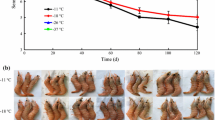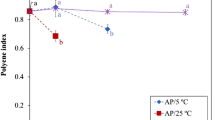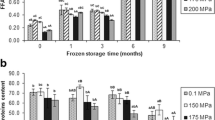Abstract
Atlantic salmon (Salmo salar) quality was evaluated by hyperbaric storage at low temperature (HS/LT; 40–60 MPa, 5–15 °C) and compared with control samples stored at the same storage temperatures (5–15 °C) and atmospheric pressure (AP). Results showed that HS/LT was efficient to slowdown spoilage microbial growth, with additional inactivation at 60 MPa/10 °C after 50 days. Contrarily, AP-5/10 °C samples exceeded the established limit after 15 days. Furthermore, the established limit of total volatile base-nitrogen was surpassed at 60 MPa/10 °C only after 30 days (contrarily to 6 days at AP/10 °C), but with stable trimethylamine-nitrogen content in the former. Formaldehyde and dimethylamine-nitrogen contents increased after 6 days of HS/LT, but only the former progressively increased until the 10th day, indicating a possible formation by the action of enzymatic activity, but also by other chemical reactions. Additionally, HS/LT slightly increased secondary product content from the lipid oxidation, although to a lower extent compared with AP (at the different storage temperatures). Concluding, HS/LT may represent an interesting methodology to control microbial activity and important physicochemical parameters (such as volatile amines, colour, and lipid oxidation) of Atlantic salmon muscle portions for 15–30 days, compared with 6 days for AP/5 °C (conventional refrigeration).

Similar content being viewed by others
References
Alfnes, F., Guttormsen, A. G., Steine, G., & Kolstad, K. (2006). Consumers’ willingness to pay for the color of salmon: a choice experiment with real economic incentives. American Journal of Agricultural Economics, 88(4), 1050–1061. https://doi.org/10.1111/j.1467-8276.2006.00915.x.
Amanatidou, A. (2000). Effect of combined application of high pressure treatment and modified atmospheres on the shelf life of fresh Atlantic salmon. Innovative Food Science & Emerging Technologies, 1(2), 87–98. https://doi.org/10.1016/S1466-8564(00)00007-2.
Antonacopoulos, N. (1960). Verbesserte Apparatus zur Quantitativer Destillation Wasserdampfflühtiger Stoffe. Zeitschrift für Lebensmittel Untersuchung und Forschung, 13, 113–160.
Aubourg, S. P. (1999). Recent advances in assessment of marine lipid oxidation by using fluorescence. Journal of the American Oil Chemists’ Society, 76(4), 409–419. https://doi.org/10.1007/s11746-999-0018-2.
Baixas-Nogueras, S., Bover-Cid, S., Veciana-Nogués, T., & Vidal-Carou, M. C. (2002). Chemical and sensory changes in Mediterranean hake (Merluccius merluccius) under refrigeration (6-8°C) and stored in ice. Journal of Agricultural and Food Chemistry, 50(22), 6504–6510. https://doi.org/10.1021/jf025615p.
Benjakul, S., Visessanguan, W., & Tanaka, M. (2004). Induced formation of dimethylamine and formaldehyde by lizardfish (Saurida micropectoralis) kidney trimethylamine-N-oxide demethylase. Food Chemistry, 84(2), 297–305. https://doi.org/10.1016/S0308-8146(03)00214-0.
Bligh, E. G., & Dyer, W. J. (1959). A rapid method of total lipid extraction and purification. Canadian Journal of Biochemistry and Physiology, 37(8), 911–917. https://doi.org/10.1139/o59-099.
Calanche, J., Samayoa, S., Alonso, V., Provincial, L., Roncalés, P., & Beltrán, J. a. (2013). Assessing the effectiveness of a cold chain for fresh fish salmon (Salmo salar) and sardine (Sardina pilchardus) in a food processing plant. Food Control, 33(1), 126–135. https://doi.org/10.1016/j.foodcont.2013.02.005.
Chapman, R. A., & Mackay, K. (1949). The estimation of peroxides in fats and oils by the ferric thiocyanate method. Journal of the American Oil Chemists’ Society, 26(7), 360–363. https://doi.org/10.1007/bf02651444.
Chung, S. W. C., & Chan, B. T. P. (2009). Trimethylamine and formaldehyde levels in main traded fish species in Hong Kong. Food Addit Contam Part B, 2(1), 3210–3251. https://doi.org/10.1080/02652030902858921.
Dalgaard, P., Gram, L., & Huss, H. H. (1993). Spoilage and shelf-life of cod fillets packed in vacuum or modified atmospheres. International Journal of Food Microbiology, 19(4), 283–294. https://doi.org/10.1016/0168-1605(93)90020-H.
Dondero, M., Cisternas, F., Carvajal, L., & Simpson, R. (2004). Changes in quality of vacuum-packed cold-smoked salmon (Salmo salar) as a function of storage temperature. Food Chemistry, 87(4), 543–550. https://doi.org/10.1016/j.foodchem.2004.01.005.
Dyer, W., & Mounsey. (1945). Amines in fish muscle II. Development of trimethylamine and other amines. Journal of the Fisheries Research Board of Canada, 6(5), 359–367. https://doi.org/10.1017/CBO9781107415324.004.
Fidalgo, L. G., Lemos, Á. T., Delgadillo, I., & Saraiva, J. A. (2018). Microbial and physicochemical evolution during hyperbaric storage at room temperature of fresh Atlantic salmon (Salmo salar). Innovative Food Science & Emerging Technologies, 45, 264–272. https://doi.org/10.1016/j.ifset.2017.11.003.
García-Soto, B., Aubourg, S. P., Calo-Mata, P., & Barros-Velázquez, J. (2013). Extension of the shelf life of chilled hake (Merluccius merluccius) by a novel icing medium containing natural organic acids. Food Control, 34(2), 356–363. https://doi.org/10.1016/j.foodcont.2013.05.007.
Ghaly, A., Dave, D., Budge, S., & Brooks, M. (2010). Fish spoilage mechanisms and preservation techniques: review. American Journal of Applied Sciences, 7(7), 859–877. https://doi.org/10.3844/ajassp.2010.859.877.
Hansen, A. A., Morkore, T., Rudi, K., Rodbotten, M., Bjerke, F., & Eie, T. (2009). Quality changes of prerigor filleted atlantic salmon (Salmo salar L.) packaged in modified atmosphere using CO2 emitter, traditional MAP, and vacuum. Journal of Food Science, 74(6), 2–9. https://doi.org/10.1111/j.1750-3841.2009.01233.x.
Hultin, H. O. (1994). Oxidation of lipids in seafoods. In F. Shahidi & J. R. Botta (Eds.), Seafoods Chemistry, Processing Technology and Quality (1st ed., pp. 49–74). London: Blackie Academic and Professional.
ICMSF. (1986). Sampling for microbiological analysis: principles and specific applications (Vol. 2, pp. 127–278). Hoboken: Blackwell Scientific Publication. https://doi.org/10.2307/1268642.
ISO 4833. (2003). Microbiology of food and animal feeding stuffs – horizontal method for the enumeration of microorganisms – colony-count technique at 30 degrees C. Geneva, Switzerland.
ISO 8523. (1991). Microbiology - general guidance for the detection of Enterobacteriaceae with preenrichment. Geneva, Switzerland.
Karim, N. U., Kennedy, T., Linton, M., Watson, S., Gault, N., & Patterson, M. F. (2011). Effect of high pressure processing on the quality of herring (Clupea harengus) and haddock (Melanogrammus aeglefinus) stored on ice. Food Control, 22(3–4), 476–484. https://doi.org/10.1016/j.foodcont.2010.09.030.
Ko, W.-C., Jao, C.-L., Hwang, J.-S., & Hsu, K.-C. (2006). Effect of high-pressure treatment on processing quality of tilapia meat fillets. Journal of Food Engineering, 77(4), 1007–1011. https://doi.org/10.1016/j.jfoodeng.2005.08.029.
Lemos, Á. T., Ribeiro, A. C., Fidalgo, L. G., Delgadillo, I., & Saraiva, J. A. (2017). Extension of raw watermelon juice shelf-life up to 58 days by hyperbaric storage. Food Chemistry, 231, 61–69. https://doi.org/10.1016/j.foodchem.2017.03.110.
Méndez, L., Fidalgo, L. G., Pazos, M., Lavilla, M., Torres, J. A., Saraiva, J. A., Vázquez, M., & Aubourg, S. P. (2017). Lipid and protein changes related to quality loss in frozen sardine (Sardina pilchardus) previously processed under high-pressure conditions. Food and Bioprocess Technology, 10(2), 296–306. https://doi.org/10.1007/s11947-016-1815-x.
Nash, T. (1953). The colorimetric estimation of formaldehyde by means of the Hantzsch reaction. Biochemical Journal, 55(3), 416–421.
Noordiana, N., Fatimah, A. B., & Farhana, Y. C. B. (2011). Formaldehyde content and quality characteristics of selected fish and seafood from wet markets. International Food Research Journal, 18(1), 125–136.
Ojagh, S. M., Núñez-Flores, R., López-Caballero, M. E., Montero, M. P., & Gómez-Guillén, M. C. (2011). Lessening of high-pressure-induced changes in Atlantic salmon muscle by the combined use of a fish gelatin-lignin film. Food Chemistry, 125(2), 595–606. https://doi.org/10.1016/j.foodchem.2010.08.072.
Ólafsdóttir, G., Martinsdbttir, E., Oehlenschbger, J., Dalgaard, P., Jensen, B., Undeland, I., et al. (1997). Methods to evaluate fish freshness in research and industry. Trends in Food Science & Technology, 8(August), 258–265.
Ortiz, J., Vivanco, J. P., Quitral, V., Larraín, M. A., Concha, G., & Aubourg, S. P. (2012). Changes in freshness during frozen storage of farmed coho salmon: effect of replacement of synthetic antioxidants by natural ones in fish feeds. North American Journal of Aquaculture, 74(2), 224–229. https://doi.org/10.1080/15222055.2012.675994.
Otero, L., Pérez-Mateos, M., & López-Caballero, M. E. (2017). Hyperbaric cold storage versus conventional refrigeration for extending the shelf-life of hake loins. Innovative Food Science & Emerging Technologies, 41, 19–25. https://doi.org/10.1016/j.ifset.2017.01.003.
Otero, L., Pérez-Mateos, M., Holgado, F., Márquez-Ruiz, G., & López-Caballero, M. E. (2019). Hyperbaric cold storage: pressure as an effective tool for extending the shelf-life of refrigerated mackerel (Scomber scombrus, L.). Innovative Food Science & Emerging Technologies, 51, 41–50. https://doi.org/10.1016/j.ifset.2018.05.003.
Ozogul, Y. (2009). Chapter 13 Methods for freshness quality and deterioration. In L. M. L. Nollet & F. Toldra (Eds.), Handbook of Seafood and Seafood Products Analysis (pp. 189–214). Boca Raton: CRC Press.
Özyurt, G., Kuley, E., Özkütük, S., & Özogul, F. (2009). Sensory, microbiological and chemical assessment of the freshness of red mullet (Mullus barbatus) and goldband goatfish (Upeneus moluccensis) during storage in ice. Food Chemistry, 114(2), 505–510. https://doi.org/10.1016/j.foodchem.2008.09.078.
Regulation (EC) No 1022/2008. (2008). Commission Regulation (EC) No 1022/2008 of 17 October 2008 amending Regulation (EC) No 2074/2005 as regards the total volatile basic nitrogen (TVB-N) limits.
Rodríguez, A., Carriles, N., Cruz, J. M., & Aubourg, S. P. (2008). Changes in the flesh of cooked farmed salmon (Oncorhynchus kisutch) with previous storage in slurry ice (-1.5°C). LWT - Food Science and Technology, 41(9), 1726–1732. https://doi.org/10.1016/j.lwt.2007.10.002.
Teixeira, B., Marques, A., Mendes, R., Gonçalves, A., Fidalgo, L., Oliveira, M., Saraiva, J. A., & Nunes, M. L. (2014). Effects of high-pressure processing on the quality of sea bass (Dicentrarchus labrax) fillets during refrigerated storage. Food and Bioprocess Technology, 7(5), 1333–1343. https://doi.org/10.1007/s11947-013-1170-0.
Tozawa, H., Erokibara, K., & Amano, K. (1971). Proposed modification of Dyer’s method for trimethylamine determination in codfish. In R. Kreuzer (Ed.), Fish Inspection and Quality Control (pp. 187–190). London: Fishing News Books Ltd.
Vázquez, M., Fidalgo, L. G., Saraiva, J. A., & Aubourg, S. P. (2018). Preservative effect of a previous high-pressure treatment on the chemical changes related to quality loss in frozen hake (Merluccius merluccius). Food and Bioprocess Technology, 11(2), 293–304. https://doi.org/10.1007/s11947-017-2010-4.
Vyncke, W. (1970). Direct determination of the thiobarbituric acid value in trichloracetic acid extracts of fish as a measure of oxidative rancidity. Fette, Seifen, Anstrichmittel, 72(12), 1084–1087. https://doi.org/10.1002/lipi.19700721218.
Yagiz, Y., Kristinsson, H. G., Balaban, M. O., & Marshall, M. R. (2007). Effect of high pressure treatment on the quality of Rainbow trout (Oncorhynchus mykiss) and Mahi (Coryphaena hippurus). Journal of Food Science, 72(9), C509–C515. https://doi.org/10.1111/j.1750-3841.2007.00560.x.
Yagiz, Y., Kristinsson, H. G., Balaban, M. O., Welt, B. A., Raghavan, S., & Marshall, M. R. (2010). Correlation between astaxanthin amount and a* value in fresh Atlantic salmon (Salmo salar) muscle during different irradiation doses. Food Chemistry, 120(1), 121–127. https://doi.org/10.1016/j.foodchem.2009.09.086.
Acknowledgements
Thanks are due to the University of Aveiro and FCT/MCT for the financial support for the QOPNA research Unit (FCT UID/QUI/00062/2019) through national founds and, where applicable, co-financed by the FEDER, within the PT2020 Partnership Agreement and for supporting the PhD grant of Liliana G. Fidalgo (SFRH/BD/96984/2013). The authors also acknowledge the financial support provided by the Consejo Superior de Investigaciones Científicas (CSIC) (Spain) through the Research Project PIE 2013-70E001.
Author information
Authors and Affiliations
Corresponding author
Additional information
Publisher’s Note
Springer Nature remains neutral with regard to jurisdictional claims in published maps and institutional affiliations.
Rights and permissions
About this article
Cite this article
Fidalgo, L.G., Castro, R., Trigo, M. et al. Quality of Fresh Atlantic Salmon (Salmo salar) Under Hyperbaric Storage at Low Temperature by Evaluation of Microbial and Physicochemical Quality Indicators. Food Bioprocess Technol 12, 1895–1906 (2019). https://doi.org/10.1007/s11947-019-02346-3
Received:
Accepted:
Published:
Issue Date:
DOI: https://doi.org/10.1007/s11947-019-02346-3




